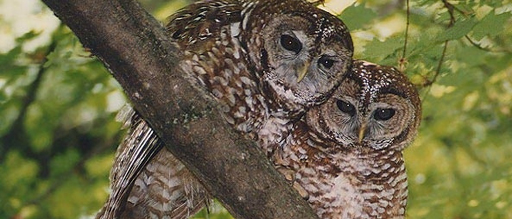The Northwest Forest Plan, the landmark 1994 compromise designed in large part to protect northern spotted owls, will not alone be sufficient to save the deep-forest bird, according to a new scientific report.
Last week, the Forest Service’s Pacific Northwest Research Station released a final “science synthesis” as part of the agency’s effort to update management plans for 17 national forests in the region.

Northern spotted owls. U.S. Fish and Wildlife Service photo.
Spotted owls face a bevy of threats, including loss of old-growth forest habitat due to decades of large-scale logging. But one threat in particular—the incursion of nonnative barred owls—has emerged over the last two decades as the preeminent threat to spotted owls, whose numbers continue to decline.
Barred owls occupy a similar ecological niche as spotted owls. But they are larger than the native birds and out-compete them for food and nesting habitat.
The new report concludes that the decline in spotted owl populations would have been more pronounced without the logging restrictions imposed by the 1994 plan.
“However, because of barred owls and continued forest perturbations outside of federal lands, the (Northwest Forest Plan) alone is not sufficient for spotted owl recovery,” the science synthesis says. “Additional measures beyond the Plan will be needed for long-term persistence of spotted owls.”
The three-volume report, which runs more than 1,000 pages, says that the impact of barred owls will “likely need to be controlled if spotted owl species recovery is to be successful.” The report notes the lack of research into “the effectiveness and moreover the feasibility of large-scale barred owl removal for conservation of spotted owls.”
Scientists paint a slightly more optimistic picture for another bird that the Northwest Forest Plan seeks to protect—the marbled murrelet. The small seabird nests in the crooks of trees high in old-growth forests. Population estimates for murrelets found that the birds are declining in Washington, relatively stable in Oregon, and increasing in northern California.
The Forest Service will host a forum in Portland next Tuesday to discuss the report’s key findings.


